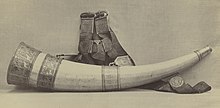
Sutton Hoo is the site of two Anglo-Saxon cemeteries dating from the 6th to 7th centuries near Woodbridge, Suffolk, England. Archaeologists have been excavating the area since 1938, when a previously undisturbed ship burial containing a wealth of Anglo-Saxon artefacts was discovered. The site is important in establishing the history of the Anglo-Saxon kingdom of East Anglia as well as illuminating the Anglo-Saxons during a period which lacks historical documentation.

Marlborough is a market town and civil parish in the English county of Wiltshire on the Old Bath Road, the old main road from London to Bath. The town is on the River Kennet, 24 miles (39 km) north of Salisbury and 10 miles (16 km) southeast of Swindon.

The Vale of Pewsey or Pewsey Vale is an area of Wiltshire, England to the east of Devizes and south of Marlborough, centred on the village of Pewsey.
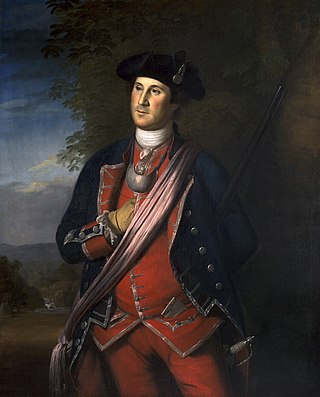
A gorget, from the French gorge meaning throat, was a band of linen wrapped around a woman's neck and head in the medieval period or the lower part of a simple chaperon hood. The term later described a steel or leather collar to protect the throat, a set of pieces of plate armour, or a single piece of plate armour hanging from the neck and covering the throat and chest. Later, particularly from the 18th century, the gorget became primarily ornamental, serving as a symbolic accessory on military uniforms, a use which has survived in some armies.

Easton Royal is a village in the civil parish of Easton in Wiltshire, England, about 3 miles (5 km) east of Pewsey and 5 miles (8 km) south of Marlborough. The village was the location of Easton Priory from 1234 to 1536. The village mistakenly gained the Royal suffix in 1838 and the name Easton Royal has been in general use since the 1850s.

Seymour, Semel or St. Maur, is the name of an English family in which several titles of nobility have from time to time been created, and of which the Duke of Somerset is the head.
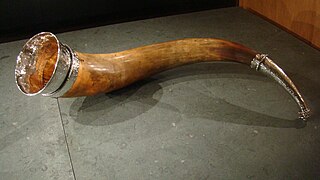
A drinking horn is the horn of a bovid used as a drinking vessel. Drinking horns are known from Classical Antiquity, especially the Balkans, and remained in use for ceremonial purposes throughout the Middle Ages and the Early Modern period in some parts of Europe, notably in Germanic Europe, and in the Caucasus. Drinking horns remain an important accessory in the culture of ritual toasting in Georgia in particular, where they are known by the local name of kantsi.

Savernake Forest stands on a Cretaceous chalk plateau between Marlborough and Great Bedwyn in Wiltshire, England. Its area is approximately 4,500 acres.

The French hood is a type of woman's headgear that was popular in Western Europe in the 16th century.

Olifant was the name applied in the Middle Ages to a type of carved ivory hunting horn created from elephant tusks. Olifants were most prominently used in Europe from roughly the tenth to the sixteenth century, although some were created later. The surviving inventories of Renaissance treasuries and armories document that Europeans, especially in France, Germany and England, owned trumpets in a variety of media and were used to signal, both in war and hunting. They were manufactured primarily in Italy, but towards the end of the fifteenth and early sixteenth centuries, they were also made in Africa for a European market. Typically, they were made with relief carvings that showed animal and human combat scenes, hunting scenes, fantastic beasts, and European heraldry. About seventy-five ivory hunting horns survive and about half can be found in museums and church treasuries, while others are in private collections or their locations remain unknown.
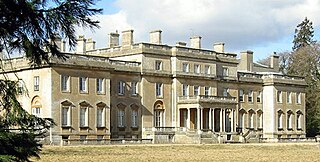
Tottenham House is a large Grade I listed English country house in the parish of Great Bedwyn, Wiltshire, about five miles southeast of the town of Marlborough. It is separated from the town by Savernake Forest, which is part of the Tottenham Park estate.

Marlborough Castle, locally known and recorded in historical documents as The Mound, was an 11th-century royal castle located in the civil parish of Marlborough, a market town in the English county of Wiltshire, on the Old Bath Road, the old main road from London to Bath. The barrow on which the fortification was built, perhaps the "barrow of Maerla", seems to be a prehistoric earthwork which formed the motte of the Norman Marlborough Castle. It survives as a tree-covered mound known as Marlborough Mound, within the site of Marlborough College.

Chandos Sydney Cedric Brudenell-Bruce, 7th Marquess of Ailesbury, styled Earl of Cardigan or Lord Cardigan between 1911 and 1961, was a British peer.
David Michael James Brudenell-Bruce, Earl of Cardigan, is the heir apparent to the marquessate of Ailesbury, and its subsidiary titles. These include Earl of Cardigan, which he currently uses as his courtesy title.
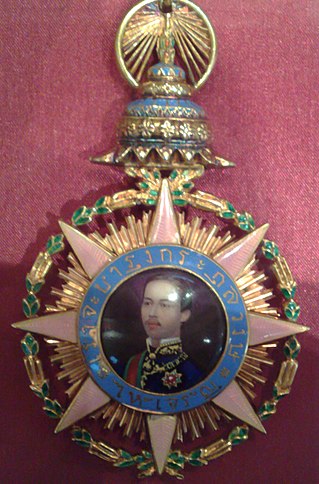
The Most Illustrious Order of Chula Chom Klao was established on 16 November 1873 by King Rama V of The Kingdom of Siam to commemorate the 90th Jubilee of the Chakri Dynasty and bears his name. The pink colour reflects the Tuesday birthday colour for King Rama V.
African ivories are objects and materials that are created from ivory or include ivory material that comes from the continent of Africa. The ivory from Africa would become widely sought after by the 14th century due in part to the poorer quality of Asian ivory. While Asian ivory is brittle, more difficult to polish, and tends to yellow with exposure to air, African ivory often comes in larger pieces, a more sought after cream color, and is easier to carve. Ivory from Africa came from one of two types of elephant in Africa; the more desirable bush elephant with larger and heavier tusks or the forest elephant with smaller and straighter tusks.

Tidcombe is a small village in Wiltshire, England, on the eastern edge of the county, near Hampshire, about 9 miles (14 km) southeast of Marlborough and 7 miles (11 km) southwest of Hungerford. With few inhabitants, it forms part of the civil parish of Tidcombe and Fosbury, which has a parish meeting.

The 1821 Coronation Honours were appointments by King George IV to various orders and honours on the occasion of his coronation on 19 July 1821. The honours were published in The London Gazette on 14, 24 and 28 July 1821.

The Ailesbury Mausoleum situated in the churchyard of St Mary's Church, Maulden, in Bedfordshire, is a Grade II listed structure built in 1656 by Thomas Bruce, 1st Earl of Elgin (1599–1663), of nearby Houghton House in the parish of Maulden, for the purpose of housing the coffin and "splendid monument" of his second wife, Lady Diana Cecil, a daughter of William Cecil, 2nd Earl of Exeter and widow of Henry de Vere, 18th Earl of Oxford. In the opinion of the architectural historian Sir Howard Colvin (1991) it is one of the first two free-standing mausoleums ever built in England, together with the Cabell Mausoleum at Buckfastleigh in Devon.

Nafir, also nfīr, plural anfār, Turkish nefir, is a slender shrill-sounding straight natural trumpet with a cylindrical tube and a conical metal bell, producing one or two notes. It was used as a military signaling instrument and as a ceremonial instrument in countries shaped by Islamic culture in North Africa, the Middle East and South Asia. In Ottoman, Persian and Mugulin miniatures, the nafīr is depicted in battle scenes. In Christian culture, it displaced or was played alongside of the curved tuba or horn, as seen in artwork of about the 14th century A.D.

